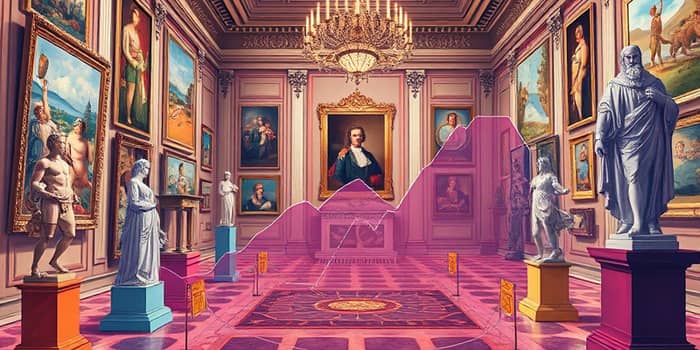
Investing in art extends beyond mere financial calculation; it encompasses emotion, culture, and an enduring legacy. In 2025, the art market presents a complex tapestry of opportunity and caution, inviting both new and seasoned collectors to weigh beauty against risk.
The global art market in 2024–2025 offers a study in contrasts. Despite economic headwinds, transaction volumes continued to rise, while values shifted across different segments.
Dealer sales showed resilience with only a 6% decline, underscoring collectors’ preference for trusted relationships over high-risk public events. Geographically, the United States retained a 43% share of global activity, trailed by the United Kingdom and China at 18% and 15%, respectively.
The high-end segment saw a notable thinning of mega-ticket transactions, with works priced above $10 million falling by 39%. Conversely, demand surged for lower-priced artworks under $5,000, driven by new entrants seeking accessibility and diversity.
Contemporary art continues to break records—Basquiat’s remarkable sale above $100 million in 2024 being a prime example—while collectors look beyond established names. Notably, there is a rise in interest from women and underrepresented groups driving demand, reflecting a broader societal push toward inclusivity and fresh perspectives.
The ways in which art changes hands have diversified rapidly. While traditional dealer networks remain central, hybrid digital platforms and private transactions have gained prominence.
Technology underpins much of this evolution. Platforms featuring live-streamed real-time auction platforms and virtual showrooms have expanded access, while blockchain and NFTs enhance provenance tracking and market transparency. Cross-border sales and digital engagement are reshaping the traditional hubs of New York, London, and Hong Kong.
Art represents a unique asset class offering potential rewards distinct from equities and bonds. It appeals to collectors seeking both personal enrichment and financial upside.
Many investors view art as a hedge against inflation and a store of value that is largely uncorrelated with stock market fluctuations. Beyond returns, art stimulates creative economies, generating what some call a multiplier effect on creative industries and cultural infrastructure.
However, average appreciation can vary widely. While headline auctions hint at spectacular gains, net returns often depend on holding periods, maintenance costs, insurance, and the timing of sales. Illiquidity remains a persistent consideration, challenging those who require quick access to capital.
No investment is without risk, and art presents a distinctive set of pitfalls. Understanding these challenges is critical for any collector.
Success in art investment often hinges on informed decision-making and professional guidance.
Ultimately, art’s allure transcends numeric returns. The intrinsic pleasure derived from an artwork can be as compelling as its financial appreciation. Collectors often balance passion with prudence, driven by the desire to preserve culture, tell stories, and craft a personal legacy.
In 2025’s landscape of technological innovation and shifting demographics, art remains a vibrant frontier. For those willing to navigate its complexities, the rewards can be profound: aesthetic fulfillment, cultural impact, and potential wealth creation in equal measure.
References













